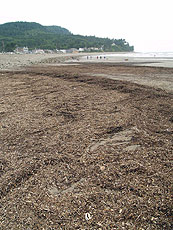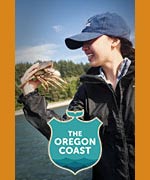 |
The Outrageous Side of Oregon Coast Beaches
Published February 2009
 |
| A massive "ocean burp" in Seaside covers a large chunk of the beach (photo Seaside Aquarium) |
(Oregon Coast) - A day at the beach in Oregon can be a bit mind-bending. The Sci-Fi Channel could find lots to be inspired by here. The ocean and the shoreline environment are some of the most dynamic places on Earth, where things constantly change, sometimes in truly freaky ways.
Beneath those calming waves we so love to get hypnotized by, there's a lot of crazy stuff going on. Strange creatures with no bones that can squeeze through a hole maybe ten times smaller than it, weird worms that secrete their own protective casing, and lots of predation by things that would be considered monsters if they were just roaming around on land.
It's not like another planet down there. And sometimes, that stuff washes up on the beaches.
When the ocean coughs up stuff, it's full of surprises. But you've often got to know what you’re looking at, because we get used to all sorts of debris on the beaches, and sometimes can’t see the forest through the trees - in a beachy way, that is.
A lot of this happens mostly during stormier times, when the ocean kicks up its own insides and stuff comes wandering onshore that was sometimes near the bottom. But even summer, with its mild mannered waves, brings its surprises.
 |
| Velella velella, or "purple sails" on the coast |
Velella velella are some of the more wacky appearances you’ll find. This form of jellyfish usually shows up more in spring and early summer, and actually has been rather mysteriously missing the last two springs on these shores. They’re often referred to as “purple sails” because of their purple color. When they show up, it’s usually in huge numbers, littering the beach with little purple and see-through dots. As they dry or get picked apart by seagulls, they lose their color even more. Then, as they dry some more, they begin rotting and create this horrific fishy smell along the beaches.
The famed - or infamous - globster, with its paranormal legends, is really just a mass of decayed flesh from some sea creature that is so decomposed it’s absolutely unrecognizable. However, the term globster has shades of meaning derived from this phenomenon being interpreted as something otherworldly, like a sea monster – probably back in less enlightened times. It’s also sometimes referred to as a blob.
Such a messy thing washed up last year at Del Rey Beach, just north of Gearhart.
It was so badly decomposed that staff from the Seaside Aquarium had few clues from which to identify it. At the time, manager Keith Chandler guessed it might be a gray whale, and even Deb Duffield from the Marine Mammal Stranding Network headquarters at Portland State University was later unable to completely figure out what it was via photos sent to her from Tiffany Boothe at the Seaside Aquarium.
It was about ten feet long and thoroughly unrecognizable, Chandler said.
 |
| Dead and disgusting: the "globster" from the north coast in recent years was some kind of whale carcass (photo Tiffany Boothe, Seaside Aquarium) |
“The whale was extremely bad smelling,” said Chandler. “It’s just a hunk of rotting flesh,” he said. “It’s just a blob. The skin is so bad and slimy it looks like fur.”
They could not get near it on that particular week because of high tide. “The last thing you want is that decomposed thing to roll over on you or just touch you, when it’s being knocked around by the tide,” said Boothe.
There were reports about this time of a dead whale that was seen floating about two miles offshore from Depoe Bay. This could’ve been it.
Last summer and fall, an unusual occurrence took place with a run of dead baby sharks washing up along the Oregon coast and the California coast. Some were actually still barely alive when they washed up on the beaches. There were dozens along the north and central coast, reported by Seaside Aquarium staff and the Hatfield Marine Science staff down in Newport. There were also numerous ones showing up in California. Most were salmon sharks and soupin sharks, but at least one Great White rolled onto the Oregon coast.
“It’s the most we’ve ever seen in such a short period of time,” Boothe said in August of 2007. “Usually, when they die, they sink to the bottom. But the dead ones have been washing up on the beaches.”
 |
| Dead shark on the coast (photo Seaside Aquarium) |
Bill Hanshumaker, Public Marine Education Specialist with the Hatfield Marine Science Center in Newport, said an alarmingly large amount of baby salmon sharks washed up on the central coast.
“I have had more than a half dozen reports of dead baby great white sharks,” Hanshumaker said that summer. “Without exception, these turn out to be baby salmon shark pups. Though I typically see one or two every summer, this year’s higher number of dead pups is unusual.”
Why or how so many were showing up on shore is a mystery, but Boothe and others at the aquarium at the time believed it probably had to do with warmer waters that year bringing in more tuna. That, in turn, will attract more fish-eaters. However, necropsies done on the creatures from California revealed they had encephalitis, a disease of the brain.
 |
| A dead dolphin washes up on the Oregon coast (photo Boothe) |
The Great White was the first to show up, in July, and was still barely alive. Later, John Rupp of the Point Defiance Aquarium in Tacoma– a nationally recognized expert on sharks - confirmed it was a Great White after being contacted by Boothe.
Dolphins sometimes show up onshore as well, usually deceased, and usually in wintertime. But sometimes they too wash in still partially alive. Several different types show up after they’ve died at sea, but some are rarer than others.
One recent winter, staff at the Seaside Aquarium found a long-beaked common dolphin – a species whose natural habitat is the Oregon coast shoreline. But what made it rare is that aquarium staff has never seen one wash up before.
 |
| The freaky lancetfish, found in Cannon Beach (photo Boothe) |
Another rarity to find on the shore is an odd, prehistoric looking fish called a Pacific Lancetfish. One was reported in Cannon Beach in 2007, while Newport’s Terry Morse saw one in 2008. Both, interestingly enough, were still alive, but not for long.
Boothe said the fish isn’t rare in these waters, but rather a “cool fish.” They usually reside in deeper waters but have been known to come in closer to shore.
How it could’ve died is an odd thing, however. Sometimes, these fish will accidentally bite themselves while partaking in a feeding frenzy.
The lancetfish's large eyes enable them to see in deep water. These are scaleless fish with large teeth and sail-like dorsal fins. Boothe said they can be found worldwide and in almost all oceans, except for the polar oceans. They range in depths from 10 to over 3,000 feet.
2006 brought a truly remarkable find during that winter. Someone reported to the Seaside Aquarium seeing a mola mola (or Ocean Sun Fish), which are quite rare to find on the north coast. This one was a special find and aquarium staff had it preserved.
Summer has its particular delights that wash up rather clandestinely, creating a really wild natural phenomenon called “glowing sand.” To the naked eye, this phenomenon looks like faint, greenish, blue sparks underneath your feet in the wet sand.
 |
| Creepy mole crabs appear in great numbers in late summer on the coast. |
The creatures are a form of phytoplankton called dinoflagellates – part of the family of microscopic plants that form the bottom of the food chain for marine life. This particular brand is bioluminescent, meaning they give off a glow when disturbed or bumped through internal chemistry processes, much in the same way a firefly does.
They tend to hit Oregon’s beaches in warmer periods when nutrients can be more abundant and more sunlight can help “charge them up.” In order to see them, you’ll need a dark beach with no light interference from lamps or the moon. Scuff your feet along the wet sand, and look for little sparks. They’re often quite hard to notice.
In the right conditions, they show up in Oregon coast bays, like at Nehalem Bay. Move your hand around in the water and you’ll see an eerie, bluish, glowing trail.
Other oddities that washed up recently include the tube casings from "cellophane worms." In late June, Morse found a huge debris field of them in Newport’s Nye Beach. These creatures live in a kind of tube, which they secrete from their bodies to protect them.
Winter, fall and even spring can bring what are known as “ocean burps.” The technical term is detritus, and it means the ocean is casting some interesting objects from the depths onto the shores – things you don’t normally find on the beaches.
Beachcombers will spot a brownish mass of wood and grassy matter from afar, but up close is a small treasure chest of natural oddities like cockleshells, hermit crabs, squid eggs, casings from other eggs, moon snail shells and somewhat rare rock finds.
“If you see a patch of dark brown on the beach, go look through it because you’ll find some cool stuff,” Chandler said.
One episode of this detritus occurred in February 2006, where Chandler found 30 live cockleshells – a form of clam. He also found numerous squid egg casings and some live squid eggs, which were incubated at the aquarium and hatched after six months.
There’s even more oddities, like summer’s wave of mole crabs, where you feel creepy little critters washing over your feet in the tide, usually in August. Or the run of baby seals you’ll see in the early summer, or the corpses of seals, porpoises or sea lions that show up anytime of year.
In the end, there’s a lot to keep your eye out for on the beaches.
More About Oregon Coast hotels, lodging.....
More About Oregon Coast Restaurants, Dining.....
LATEST OREGON COAST NEWS STORIES
NEW: Portland, Oregon Highway Traffic, Road Conditions - Traffic Cams: I-5 - ... |
Secrets of the Season |
Unusual Travel Articles TravelParanormal.com allows you to submit your own creepy tale or debunk one - or see up-to-the-minute news headlines about travel and the paranormal. News Headlines from All Over Oregon Need to scan Oregon headlines? Constantly updated news from all over Oregon: a comprehensive, up-to-the-minute display of news headlines from a variety of media |
Back to Oregon Coast









































